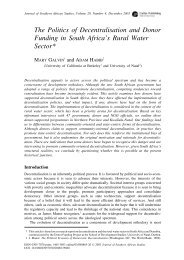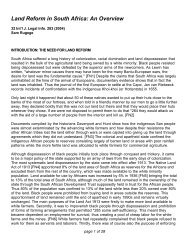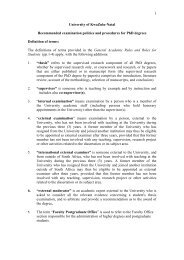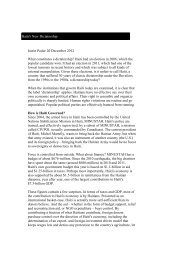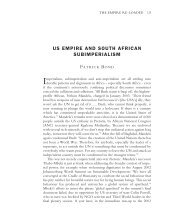Bell, Trevor : Unemployment in South Africa
Bell, Trevor : Unemployment in South Africa
Bell, Trevor : Unemployment in South Africa
Create successful ePaper yourself
Turn your PDF publications into a flip-book with our unique Google optimized e-Paper software.
(bl What though of a Black who loses his job <strong>in</strong> a textiles factory <strong>in</strong><br />
Durban due to greater ccmpetition from the Far East, and leaves for<br />
"the farm" <strong>in</strong> Hapumulo. Say he "works" six hours per reek for R5,00<br />
there and so is regarded as fully employed <strong>in</strong> term of the criteria<br />
used by the Current Population Survey. In the aggregate therefore the<br />
rate of unemployment is unchanged. Is this reasonable?<br />
There has <strong>in</strong> fact been a drastic reduction <strong>in</strong> the utilization of this<br />
worker's labour services. Thus, it seems to me, to say that the<br />
unemployment rate is unchanged is to fail to capture the essence of<br />
what has happened. The unemployment <strong>in</strong>dex would fail ccmpletely to<br />
reflect the fact that the situation so far as the availability of<br />
work was concerned had clearly deteriorated. A measure of<br />
unemployment <strong>in</strong>corporat<strong>in</strong>g underemployment, however, would reflect<br />
thisl).<br />
These two meaaures thus could produce quite different time trends,<br />
and the choice of def<strong>in</strong>ition becomes critical for any analysis of the<br />
cyclical or secular dynamics of the problem of unemployment. Indeed,<br />
it is noteworthy that the CPS shows a significant drop <strong>in</strong> the Black<br />
unemployment rate between Wtober 1977 and June 1978 from 12.5 to<br />
10.1 per cent, aga<strong>in</strong>st all the other <strong>in</strong>dicators. For <strong>in</strong>stance, over<br />
this same period accord<strong>in</strong>g to Simk<strong>in</strong>s, the all-races unemployment<br />
rate (with Black unemployment predom<strong>in</strong>ant) rose from 18.4 per cent to<br />
20,4 per cent, and accord<strong>in</strong>g to mots the Black unemployment rate<br />
rose from 16,2 to 18.4 per cent. hlrthermore, the rate of registered<br />
unemployment of Whites, Coloureds and Asiana, as illustrated <strong>in</strong><br />
Figure 2 also rose significantly, and there is no apparent reason why<br />
the Black unemployment rate should have been mov<strong>in</strong>g <strong>in</strong> the oppoaite<br />
direction. Also, this decl<strong>in</strong>e <strong>in</strong> the Black unemployment rate<br />
conflicts with the picture presented <strong>in</strong> Table 7 and Figure 3 above,<br />
which show rates of growth of non-agricultural employment of -1,29<br />
and -2,26 <strong>in</strong> 1977 and 1978 respectively, <strong>in</strong> view of which we should<br />
1) The same considerations would apply even if the <strong>in</strong>dividual worked the<br />
same hours as he did <strong>in</strong> tom, but for, say, one twentieth of the<br />
return.




